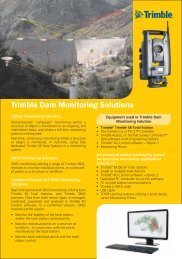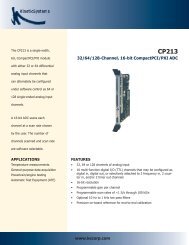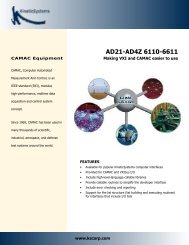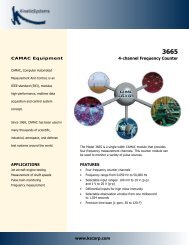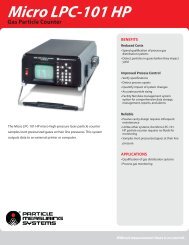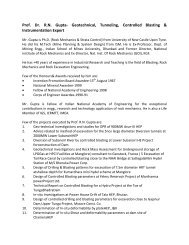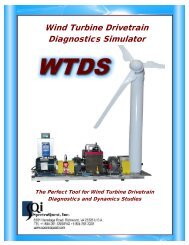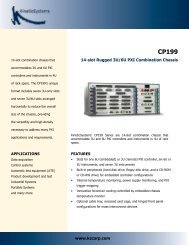PISTONPHONES AND CALIBRATION EQUIPMENT
PISTONPHONES AND CALIBRATION EQUIPMENT
PISTONPHONES AND CALIBRATION EQUIPMENT
Create successful ePaper yourself
Turn your PDF publications into a flip-book with our unique Google optimized e-Paper software.
<strong>PISTONPHONES</strong><br />
<strong>AND</strong> <strong>CALIBRATION</strong> <strong>EQUIPMENT</strong><br />
Calibration is an essential step in every precision noise<br />
measurement. It establishes the relationship between<br />
the sound pressure acting on a microphone and the<br />
resulting electrical output of the microphone. There are<br />
basically two properties of a measurement microphone<br />
requiring calibration, these are: level calibration and a<br />
frequency-response calibration.<br />
Level calibration determines the absolute sensitivity of<br />
the measurement microphone. Various methods can be<br />
used, e.g. reciprocity, comparison, pistonphone or calibrator.<br />
a) Reciprocity is normally considered the most accurate<br />
of methods but is elaborate and expensive.<br />
b) Comparison is where the sensitivity of the microphone<br />
under test is compared with the known<br />
sensitivity of a reference microphone. It is simple<br />
and can be done with commonly-available equipment<br />
and requires minor investment.<br />
c) A pistonphone, with a precision barometer for<br />
applying static pressure corrections, is a robust<br />
and highly reliable method of level calibration at<br />
250Hz.<br />
• At 250Hz, the frequency response of most<br />
microphones is flat and will give a more accurate<br />
result.<br />
d) A calibrator is a convenient way of calibrating a<br />
microphone at 1000Hz but does not have the<br />
same precision as a pistonphone. Neither does it<br />
require static-pressure corrections.<br />
• At 1000Hz, weighting filters have 0dB attenuation<br />
and will therefore not affect the calibration.<br />
In these cases it might be an advantage to use a<br />
1000Hz calibration tone.<br />
<strong>PISTONPHONES</strong> <strong>AND</strong> <strong>CALIBRATION</strong> <strong>EQUIPMENT</strong><br />
46
A frequency-response calibration describes the<br />
response of the microphone over a range of frequencies.<br />
Frequency-response measurements can be presented<br />
in various ways, i.e. pressure response, freefield<br />
response and diffuse-field response.<br />
Generally, pressure response is determined by using an<br />
electrostatic actuator which simulates purely an oscillating<br />
pressure exerted on the microphone’s<br />
diaphragm. Free-field and diffuse-field responses can<br />
then be arrived at by adding predetermined correction<br />
values to the measured actuator (pressure) response of<br />
the microphone.<br />
Electrostatic actuators require no special acoustic laboratory<br />
facilities since background noise is not too critical<br />
a factor.<br />
An electrostatic actuator consists of an electrically conductive<br />
rigid plate mounted close to, and parallel with,<br />
the microphone’s diaphragm. When an oscillating voltage<br />
is applied between the microphone’s housing and<br />
the electrostatic actuator, an oscillating force will be<br />
exerted on the diaphragm. This oscillating force simulates<br />
an oscillating sound pressure, thus making it possible<br />
to determine the response of the microphone to<br />
pressure alone. This means that the frequency response<br />
of microphones can be measured under normal circumstances,<br />
not requiring special sound insulated test<br />
chambers, as long as the background noise levels are<br />
reasonable low.<br />
The pistonphone works on the principle of a pair of<br />
similar opposing, reciprocating pistons actuated by a<br />
precision-machined cam disc with a sinusoidal profile.<br />
The profile of the cam disc is such that the pistons follow<br />
a sinusoidal movement at a frequency equal to<br />
four times the speed of rotation. This results in a corresponding<br />
sinusoidal variation in the effective volume of<br />
the closed coupler and, consequently, an acoustic signal<br />
within it.<br />
The mechanical structure of the pistonphone makes<br />
this generated acoustic pressure signal very reliable and<br />
stable. By careful control of the atmospheric pressure<br />
conditions and the calibration temperature, the calibration<br />
far exceeds the requirements for class LS calibrators.<br />
Absolute calibration accuracy has been determined<br />
to be within ±0.05dB at reference conditions for<br />
the pistonphone.<br />
47 <strong>PISTONPHONES</strong> <strong>AND</strong> <strong>CALIBRATION</strong> <strong>EQUIPMENT</strong>
<strong>PISTONPHONES</strong> <strong>AND</strong> <strong>CALIBRATION</strong> <strong>EQUIPMENT</strong><br />
Type 42AA<br />
Pistonphone<br />
Precision sound source for<br />
calibrating microphones,<br />
sound level meters and other<br />
sound measuring equipment.<br />
Battery operated and produces<br />
a constant nominal<br />
sound pressure level of<br />
114dB re. 20µPa (equivalent<br />
to 10 Pa) at 250Hz, or<br />
105.4dBA re. 20µPa. Each<br />
Type 42AA is within 0.1dB of<br />
the nominal value and is<br />
delivered with an individual<br />
calibration chart and a<br />
barometer for Class 1 static<br />
pressure corrections. For<br />
Class 0 static pressure corrections,<br />
a precision barometer<br />
is required.<br />
Type 42AA can be used both<br />
for field checks of complete<br />
measurement systems as well<br />
as for laboratory calibrations of measurement microphones.<br />
It complies with the requirements of IEC 942<br />
(1988) Class 1 and is PTB approved.<br />
Included accessories:<br />
RA0049<br />
Adapter for 1/4” microphones.<br />
RA0069<br />
Adapter for 1/8” microphones.<br />
Available accessories:<br />
RA0023<br />
Coupler for 1” microphones.<br />
RA0024<br />
Two-port calibration coupler.<br />
RA0025<br />
Octopus coupler for 1/4” microphones.<br />
RA0072<br />
Octopus Coupler for 1/2” microphones.<br />
RA0090<br />
94 dB Adapter.<br />
Type 42AC<br />
High-pressure Pistonphone<br />
Precision sound source for<br />
calibrating microphones,<br />
sound level meters and other<br />
sound measuring equipment<br />
at high levels. Battery operated<br />
and produces a constant<br />
nominal sound pressure level<br />
of 134 dB re. 20 µPa (equivalent<br />
to 100 Pa) at 250Hz, or<br />
125.4 dBA re. 20 µPa. Each<br />
Type 42AC is within 0.1 dB<br />
of the nominal value and is<br />
delivered with an individual<br />
calibration chart and a<br />
barometer for Class 1 static<br />
pressure corrections. For<br />
Class 0 static pressure corrections,<br />
a precision barometer<br />
is required.<br />
The Type 42AC can be used<br />
both for field checks of complete<br />
measurement systems<br />
as well as for laboratory calibrations of measurement<br />
microphones. It complies with the requirements of IEC<br />
942 (1988) Class 1.<br />
An adapter (GR0398) is included for use with<br />
hydrophone couplers.<br />
Included accessories:<br />
RA0049<br />
Adapter for 1/4” microphones.<br />
RA0069<br />
Adapter for 1/8” microphones.<br />
Available accessories:<br />
RA0023<br />
Coupler for 1” microphones.<br />
RA0042<br />
Two-port high-pressure calibration coupler.<br />
RA0025<br />
Octopus coupler for 1/4” microphones.<br />
RA0072<br />
Octopus Coupler for 1/2” microphones.<br />
<strong>PISTONPHONES</strong> <strong>AND</strong> <strong>CALIBRATION</strong> <strong>EQUIPMENT</strong><br />
48
<strong>PISTONPHONES</strong> <strong>AND</strong> <strong>CALIBRATION</strong> <strong>EQUIPMENT</strong><br />
Type 42AP<br />
Intelligent Pistonphone<br />
Battery-operated, precision<br />
sound source for calibrating<br />
microphones, sound level<br />
meters and other sound<br />
measuring equipment. Has<br />
built-in precision barometer<br />
and thermometer. Via its display<br />
and RS-232 interface,<br />
the user can read the actual<br />
corrected sound pressure<br />
level, as well as the calibration<br />
temperature and ambient<br />
static pressure.<br />
It produces a constant nominal<br />
sound pressure level of<br />
114 dB re. 20 µPa (equivalent<br />
to 10 Pa) at either<br />
250Hz or 251.2Hz (true centre<br />
frequency of a 250Hz,<br />
1/3-octave band filter).<br />
The actual sound pressure<br />
level, corrected for static<br />
ambient pressure, is shown on its display which can<br />
also show the A-weighted sound pressure level after<br />
correcting it for using an A-weighting filter.<br />
• Type 42AP is an extremely stable laboratory standard<br />
sound source which can also be used for field<br />
calibrations - it retains its high accuracy even under<br />
hostile environmental conditions. It complies with all<br />
the requirements of IEC Standard 60942 (2003) LS.<br />
• An individual calibration chart is delivered with each<br />
Pistonphone.<br />
Included accessories:<br />
RA0023<br />
Coupler for 1” microphones.<br />
RA0049<br />
Adapter for 1/4” microphones.<br />
RA0069<br />
Adapter for 1/8” microphones.<br />
AA0050<br />
RS-232 interface cable.<br />
The display can be switched to show any of the following:<br />
• Actual corrected sound pressure level in decibels.<br />
• Actual corrected sound pressure level in decibels if<br />
measured with an A-weighting filter.<br />
• Static air pressure in hPa.<br />
• Calibration temperature in ºC.<br />
• Calibration temperature in ºF.<br />
• The Pistonphone frequency can be programmed, via<br />
its RS-232 interface, to be either 250Hz or 251.2Hz.<br />
Available accessories:<br />
RA0024<br />
Two-port calibration coupler.<br />
RA0025<br />
Octopus coupler for 1/4” microphones.<br />
RA0072<br />
Octopus Coupler for 1/2” microphones.<br />
RA0090<br />
94 dB Adapter.<br />
Specifications 42AA 42AC 42AP<br />
Sound pressure level 114 dB (re. 20µPa) ±0.08 dB 134 dB (re. 20µPa) ±0.08 dB 114 dB (re. 20µPa) ±0.05 dB<br />
Frequency 250 Hz 250 Hz 250 Hz or 251.2 Hz<br />
Accuracy IEC 942 (1988) IEC 942 (1988) IEC 60942<br />
Class 1 Class 1 (ed.3/FDIS )LS<br />
Temperature range –10 °C to +55 °C –10 °C to +55 °C –10 °C to +55 °C<br />
Batteries 4 x AA alkaline (IEC LR 6) 4 x AA alkaline (IEC LR 6) 4 x AA alkaline (IEC LR 6)<br />
External power – – 6V DC 125mA<br />
Weight (with batteries) 325 g 325 g 437 g<br />
49 <strong>PISTONPHONES</strong> <strong>AND</strong> <strong>CALIBRATION</strong> <strong>EQUIPMENT</strong>
<strong>PISTONPHONES</strong> <strong>AND</strong> <strong>CALIBRATION</strong> <strong>EQUIPMENT</strong><br />
Type 42AB<br />
Sound Calibrator<br />
Type 14AA<br />
Electrostatic Actuator Amplifier<br />
Pocket-sized, battery operated calibrator for microphones,<br />
sound level meters and other sound measuring<br />
equipment. Produces a constant nominal sound<br />
pressure level of 114 dB re. 20 µPa (equivalent to 10<br />
Pa) at 1kHz. Easy to use and requires no corrections<br />
for ambient pressure changes or microphone equivalent<br />
volume. Includes adapters for calibrating 1”,<br />
1/2” and 1/4” microphones. The Type 42AB complies<br />
with the requirements of IEC 942 (1988) Class 1.<br />
High-voltage, high-gain amplifier and voltage supply<br />
for driving electrostatic actuators. The high-voltage<br />
output can also be used to drive standard microphones<br />
as sound sources. The Type 14AA can drive<br />
an electrostatic actuator with a 300 V peak-to-peak<br />
signal superimposed on 800 V DC. Its wide frequency<br />
range makes it possible to determine the pressure frequency<br />
response of condenser microphones from<br />
200Hz to 200kHz (note: care should be taken below<br />
200Hz because of the influence of pressure equalisation<br />
in the rear volume of the microphone). The Type<br />
14AA can be connected directly to an external signal<br />
generator or the generator output of any standard<br />
signal analyzer.<br />
Specifications<br />
Type 42AB<br />
Sound pressure level<br />
114 dB (re. 20 µPa) ± 0.2 dB<br />
Frequency<br />
1 kHz<br />
Temperature range – 10 °C to + 50 °C<br />
Batteries<br />
6LR61, 9 V<br />
Accuracy IEC 942 (1988) Class 1<br />
Weight<br />
220 g<br />
Specifications<br />
Input signal (max)<br />
Gain<br />
Output signal (max)<br />
Actuator Polarisation Voltage<br />
Frequency response<br />
Output impedance<br />
Power supply<br />
Weight<br />
Type 14AA<br />
3 V peak-to-peak<br />
+ 40 dB<br />
300 V peak-to-peak<br />
800 V<br />
1 Hz – 200 kHz<br />
1 k Ω<br />
110 /130 V AC or 220/240 V AC<br />
1.4 kg<br />
<strong>PISTONPHONES</strong> <strong>AND</strong> <strong>CALIBRATION</strong> <strong>EQUIPMENT</strong><br />
50
<strong>PISTONPHONES</strong> <strong>AND</strong> <strong>CALIBRATION</strong> <strong>EQUIPMENT</strong><br />
RA0014<br />
1/2” Electrostatic Actuator<br />
AL0010<br />
Calibration Stand<br />
An electrostatic actuator for testing the frequency<br />
response of standard 1/2”, 1/4” and 1/8” microphones.<br />
Adapters are included for testing 1/4” and<br />
1/8” microphones. The RA0014 can be connected<br />
directly to the Actuator Supply Type 14AA.<br />
RA0015<br />
1” Electrostatic Actuator<br />
An electrostatic actuator for testing the frequency<br />
response of standard 1” microphones. The RA0015<br />
can be connected directly to the Actuator Supply<br />
Type 14AA.<br />
Provides a convenient platform for testing condenser<br />
microphones. It has a fixture for holding a 1/2” preamplifier<br />
(e.g. Type 26AK) securely in place as well as<br />
recesses and a column for safely parking electro-static<br />
actuators (i.e. RA0014 and RA0015) and microphone<br />
protection grids when not in use. It can be set-up for<br />
both 1/2” and 1” microphones.<br />
The AL0010 is a useful addition to a set up (which<br />
includes an Electrostatic Actuator Amplifier Type<br />
14AA) for routinely calibrating condenser microphones.<br />
51 <strong>PISTONPHONES</strong> <strong>AND</strong> <strong>CALIBRATION</strong> <strong>EQUIPMENT</strong>




